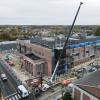Washington growers finding success with Viognier
Lately, Going Forward Pinot Noir 2011 has been pushed as a lovely, fruit-forward, Sonoma PN, rated 90 points and priced under $20. After sampling, I agreed and wrote of it here. Subsequently, I was shown another Sonoma Coast PN that I found had better QPR. Sarapo Family Wines North Coast Donato Lot Two 2011 is a blend of small-lot wines from Napa, Carneros and Russian River Valley producers. It was composed by Kent Humphries, the winemaker at Eric Kent Wine Cellars. Although the 2011 vintage is a bit less than the vaunted 2009 from the region, Humphries has managed to blend a lovely wine that can be bought under $20.The color is medium ruby. As you pour, the complex bouquet expands rapidly. Raspberry, strawberry, forest floor and cola, aromas typical to well-made PN, are easily detectable. On the medium but balanced palate I found cranberry and raspberry flavors. These continued through the finish with added hints of cola and spices. It will probably take some work on the part of your wine guy to get this, but worth the effort. Keep your eyes peeled for Humphries’ wines. He is very talented. The GF 2011 is still a good choice when bought under $20.
The 2007 Poggio Nardone Brunello (BdM) has come off its highs and is screaming buy! After WE, Suckling and Tanzer touted it, the 2007 leaped in price from $38 to north of $60. It can be found right now at $33 if you buy a case of 12. The wine will enter its window this winter and should cellar well through 2020. I bought some just after release. In April 2012, I initially reviewed it with a “keep your powder dry.” I just saw the whites of their eyes. If you are BdM fans jump in.
For those who enjoy St. Estephe, the second label, La Dame de Montrose St. Estephe 2008 is findable under $40/bottle in Washington, D.C. The rating on these was all over the lot, from 86 to 93. My guru on St. Estephe is Jancis Robinson. When she came in with a 17/20, high for her, I tried some then bought a case. The glut of terrific Bordeaux from 2009-11 has kept a lid on the 2008 pricing. Recently, I located more priced under $45. It is still young, but I think the window opens next year and extends well past 2025.
Domaine de Marcoux Chateauneuf du Pape 2007, recommended in 2010, is starting to turn a bit brick-colored. Usually this is a clear sign the wine is staring to slide a bit, but in this case it was misleading. It actually needed aeration to show itself, confirming it is still improving. The bouquet is very complex and takes some time. Lavender, violet, garrigue, road tar, pepper and plums prevail, but there is nuance from anise and cherry. On the palate a bit alcoholic at 15.5 percent with enough fruit and barrel spice riding a mineral, acid, tannin balance to be pleasing. A long finish is enhanced by raspberry preserve flavors. Don’t wait to begin drinking; it is ready now.
I located another wonderful Washington wine. Maison Bleue Viognier Notre Vie Arthur’s Vineyard 2010, 92 points when priced less than $25, is a lovely, Old World, floral Viognier. David Schildknecht, a wine writer whose prose delights me, touted me on this wine. So did Tanzer. Apricots, peaches, acacia and watercress peppery aromas follow onto the rich, leesy palate. The 13.5 percent alcohol is not offensive as there is plenty of body supporting the palate. The same writers claim the 2011 is even better, but I have not sampled it yet. This is limited production and will be tough to locate, but Suburban Wines has it.
I am a huge fan of Viognier. Unfortunately, it is a difficult grape. Many on the market are less than stellar. Some of the Washington growers seem to be on track, and it will be fun to watch them grow as they try to find the Condrieu and Chateau Grillet formula. Keep in mind that in 1965 there were just 8 hectares (about 20 acres) of Viognier being grown worldwide, and all of it in Northern Rhone. An acre is a square of 208.71 feet. Horton down in Virgina is regarded as the U.S. best domestic Viognier. Dennis Horton claims that when he planted Viognier at his vineyard, about 20 miles from Monticello, there were only 300 acres planted worldwide. That was in 1992.


















































